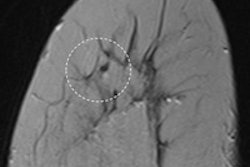
It may come as no surprise, but a new study indicates that breast imaging has the highest risk of medicolegal claims compared with other medical imaging exams, at least in Australia, according to a study published online this month in the Journal of the American College of Radiology.
Australian researchers examined closed medicolegal claims to determine which imaging modalities and types of errors tended to spark lawsuits, with the hope of finding strategies to improve patient safety -- and reduce litigation. They found that breast imagers may be particularly vulnerable (JACR, 16 June 2015).
"Our results agreed with previous international descriptive studies in that we identified breast imaging as being at high risk of leading to a medicolegal claim," co-author Tim Schultz, PhD, of the University of South Australia in Adelaide, told AuntMinnie.com via email. "In fact, we found that two of the three highest procedural risk ratios were related to breast imaging -- mammography (highest) and breast ultrasound (third highest)."
Safety in radiology
Schultz and colleagues analyzed 401 closed medicolegal claims that had been reported by two medical indemnity insurers to Australia's Radiology Events Register (RaER), which is part of a broader research program in Australia that is investigating patient safety in radiology, Schultz said. One arm of this larger project has been to actively promote incident reporting by radiologists, which led to the establishment of the RaER database of adverse events and near misses.
"For our study, we approached Australasian medical defense organizations to provide us with their deidentified closed claims data in which one or more radiologists were named in the claim, or an alleged adverse patient outcome relating primarily to a radiological procedure was the subject of the claim," Schultz said.
Schultz and colleagues classified the claims data according to error categories, and they calculated the litigation risk for CT, ultrasound, radiography, MR, and nuclear medicine. By far, the top error category was misdiagnosis -- the delay or failure to correctly read imaging and thus to correctly diagnose disease.
| Top 5 error types resulting in medicolegal claims | |||||
| Error category | Percentage of claims | ||||
| Misdiagnosis: Delay or failure to correctly read imaging exam | 62% | ||||
| Problem during a procedure (i.e., hemorrhage during a biopsy) | 11% | ||||
| Postprocedural complication (infection, unexpected pain, loss of function) | 6% | ||||
| Injury from procedure (falling or fainting during procedure) | 4% | ||||
| Missing radiology report | 3% | ||||
In all, 67% of claims involved a single imaging modality, the researchers found, with radiography having the highest percentage of misdiagnosis, at 33.8%. Ultrasound came in second at 19.9%, and CT was third at 10.7%.
The modalities and procedures with a higher risk of a legal claim were mammography, breast ultrasound, total-body MR, total-body CT, and ob/gyn ultrasound. Lower-risk modalities and procedures were cardiac ultrasound, radiography of the extremities, and total-body radiography.
Although closed claims data are helpful for creating an overall picture of which imaging modalities are more vulnerable to medicolegal claims, their usefulness could be improved, the authors wrote. No information was provided about the predisposing causes of error, potential mitigating factors, actions taken, or patient outcomes, and the data rarely addressed key patient safety characteristics that would allow the information to be used proactively for quality improvement.
"The purpose of gathering data at the time a claim is lodged is unrelated to designing strategies that might prevent a similar claim in the future," the group wrote. "However, standardization of the data fields gathered by medical defense organizations at the time of claim lodgment would be relatively simple and could help improve the value of closed claims data for this purpose."
Containing risk
How can breast imagers protect themselves? By being thorough, Schultz said.
"Best practice for possible breast cancer should include completing the 'triple test' -- clinical assessment, imaging, and, when appropriate, needle biopsy -- and other interventions such as using tomosynthesis and ultrasound as adjuncts to mammography," he told AuntMinnie.com. "It is possible that breast imaging performed in multidisciplinary clinics, where concurrent clinical evaluation and imaging can be correlated more easily, as well as having a system to follow up all biopsy results, could reduce claims against radiologists involved in breast imaging."



















